In a world where traditions can often fade away with the sands of time, the art of clay silk weaving stands as a remarkable testament to skill and dedication. The only man left practicing this non-heritage craft has been weaving silk using the clay method for nearly fifty years. His journey in this intricate and nuanced world is a blend of artistry, history, and the bittersweet reality of a vanishing skill. Silk weaving itself is an ancient practice, with roots that stretch back thousands of years, intertwined with the stories of civilizations and cultures.
Connection between silk and clay
The connection between silk and clay may seem unusual at first glance, but upon closer inspection, it reveals a deep and rich narrative of human ingenuity. The story begins long ago when early weavers sought to create textiles that were not only functional but also beautiful. This particular method of weaving silk using clay is unique; it incorporates elements that are not typically associated with traditional textile production. In contrast to the more familiar silkworm cultivation, this technique celebrates the raw materials and the tactile nature of weaving itself. The clay provides a structural element, allowing for intricate designs and patterns that tell a story of their own. As we delve deeper into the process, it becomes evident that this form of weaving is not merely about producing fabric but is also an artistic expression grounded in cultural identity.
The artistry involved in clay silk weaving requires a profound understanding of both the materials used and the techniques employed. Each strand of silk, every twist of clay, is a deliberate act of creation that honors the past while pushing the boundaries of what can be achieved in textile art. The old man’s workshop is a sanctuary of creativity, filled with the vibrant colors of dyed silk and the earthy tones of clay. Here, amidst the scattered remnants of past projects and the tools of the trade, he effortlessly melds tradition with innovation. His hands, weathered and skilled, navigate the complexities of weaving with a grace that comes from decades of practice. Each piece he creates is imbued with his personal touch, a narrative that reflects not only the technique but his passion for the craft. However, the story does not end with the beauty of the woven pieces. There exists a stark reality that looms over this old man’s craft: a lack of interest from the younger generation. Despite the rich heritage and the artistry involved, few are willing to learn this non-heritage skill. The reasons for this trend are manifold, ranging from the allure of modern technology to the fast-paced lifestyle that leaves little room for traditional crafts.

Preserve weaving skills
Many young people are drawn to more contemporary trades and skills that promise immediate economic returns. This shift poses a significant threat to the survival of clay silk weaving, as the knowledge and techniques cannot be passed down without eager learners to take up the mantle. The old man often reflects on this reality with a sense of melancholy. As he gazes at his loom, he cannot help but wonder who will carry on this ancient art form. It is a burden he bears with dignity, striving to keep the flame of his craft alive even as the world around him changes. He has tried various ways to engage the youth, hosting workshops and demonstrations, sharing his passion in hopes of igniting a spark of interest.
Yet, the response often falls short of his expectations. This struggle for preservation is not unique to clay silk weaving; it is a narrative echoed across various traditional crafts worldwide. The urgency to revive interest in these skills is paramount. As the old man continues to weave, he becomes a custodian of history, embodying the spirit of the artisans who have come before him. His work transcends the physical realm; it is a living archive of culture and identity woven into every piece of silk. The intricate patterns and designs become a dialogue between past and present, a connection that he hopes will inspire future generations to appreciate the beauty of traditional craftsmanship. In recognizing the struggles of the lone artisan, we must also explore the broader implications of losing such skills. The disappearance of unique crafting techniques like clay silk weaving would mark a significant cultural loss. Each craft holds a unique place in the tapestry of human history, contributing to our understanding of cultural diversity and identity. The patterns woven into textiles often tell stories of the communities that created them, reflecting their values, beliefs, and history.
Preserving these skills is not merely about maintaining a craft; it is about honoring the legacy of those who walked before us. As we ponder the future of clay silk weaving, it becomes evident that the old man’s story is more than just an individual journey; it is a reflection of the challenges faced by traditional artisans in a rapidly changing world. His dedication to this craft serves as a beacon of hope, reminding us of the richness of human creativity and the importance of preserving our cultural heritage. The future may be uncertain, but the legacy of clay silk weaving will continue to inspire those who appreciate the beauty of craftsmanship and the stories embedded within every woven piece.
In an age where fast fashion dominates, the old man’s work stands as a powerful counter-narrative, urging us to slow down and appreciate the artistry that goes into creating something truly remarkable. Through his eyes, we see not only the art of clay silk weaving but also the heart and soul of a tradition that deserves to be cherished and revived for generations to come. As we conclude this exploration of the last artisan of clay silk weaving, we are left with a profound appreciation for the delicate balance between tradition and modernity. It is a reminder that while the world may evolve, the roots of our cultural identity remain deeply intertwined with the skills and crafts that have shaped our history. It is our collective responsibility to acknowledge and support these unique art forms, ensuring that they continue to flourish in the face of adversity. The journey of the old man weaving silk with clay is not just a story of survival; it is a celebration of human creativity that resonates through time, urging us to keep the flame of traditional craftsmanship alive.

Challenges lie ahead
As we turn our focus to the revival of the lost art of clay silk weaving, we must confront the numerous challenges that lie ahead for both the old man and the craft he represents. The stark reality is that traditional skills are often overshadowed by the rapid advancements of modern technology, which captivates the younger generation. This begs the question: why does this particular art form face such apathy? The allure of instant gratification in the digital age is undeniable, with the younger demographic drawn toward careers and hobbies that offer immediate economic benefits and societal validation. The painstaking process of clay silk weaving, in contrast, demands patience, dedication, and time—qualities that seem to be diminishing in our fast-paced world.
The old man’s heart aches as he witnesses the dwindling interest. His attempts to engage the youth—whether through workshops, public demonstrations, or storytelling—often yield disappointing results. The essence of his craft, rich in history and artistry, struggles to find a foothold amidst the cacophony of selfies and social media trends. The stories he tells, woven with passion and nostalgia, seem to fall on deaf ears. While he yearns for someone to take up the mantle, they appear more captivated by the latest mobile app than the intricate process of weaving silk with clay.
This struggle is not merely a personal battle; it is emblematic of a broader cultural dilemma. Across the globe, artisans of traditional crafts face similar challenges. The lack of interest in the painstaking techniques and narratives that define their crafts fosters a sense of urgency. This urgency is not just about preserving a skill; it is about preserving a piece of human history that connects generations through the threads of tradition.
The responsibility of reviving this lost art does not solely rest upon the shoulders of the old man. Communities, educational institutions, and cultural organizations must collaborate to create an environment where traditional skills can flourish. Schools that introduce students to the world of artisan crafts can cultivate interest and appreciation. Envision classes where children learn the delicate dance of weaving alongside history lessons that articulate the significance of the art form. The old man’s workshop can evolve into a community hub, inviting local families to experience the tactile joy of weaving, fostering a sense of belonging and connection to the past.
Moreover, the narrative surrounding clay silk weaving must be reframed in a way that resonates with younger generations. In a world where sustainability and mindfulness are becoming increasingly popular, the values inherent in traditional craftsmanship can serve as powerful motivators. By emphasizing the environmental impact of fast fashion and the beauty of handmade artistry, this unique craft can be positioned as not only relevant but also essential in today’s world.
Social media can also play a pivotal role in this revival. The old man may not be well-versed in digital communication, but by collaborating with younger creatives, he can share his craft with a broader audience. Visual storytelling that captures the beauty and intricacy of weaving can ignite curiosity and admiration. Engaging narratives, coupled with stunning visuals, can spread awareness and appreciation for this non-heritage skill, potentially inspiring a new generation of artisans.
The importance of mentorship cannot be overstated. If the old man can find a few passionate individuals who are willing to learn, he could cultivate a legacy that extends beyond his own lifetime. The dynamic of mentor-student relationships can breathe new life into clay silk weaving, allowing young apprentices to tap into the wisdom and techniques cultivated over decades. Together, they can explore new interpretations of the craft, bridging the gap between tradition and modernity.
Furthermore, as the old man continues to weave, he should not underestimate the power of storytelling. Each piece he creates carries a narrative, a history that links him to the artisans of the past. By sharing these stories—through public speaking events, local exhibitions, or even a written memoir—he can draw people into the world of clay silk weaving. When individuals understand the significance and beauty behind each woven piece, they are more likely to appreciate the craft and perhaps even become involved.

In contemplating the future of clay silk weaving, it is crucial to acknowledge the role that cultural heritage plays in shaping identity. Traditional crafts are not merely hobbies; they embody the essence of communities, reflecting values, beliefs, and histories. As the old man weaves, he stitches together the cultural threads that bind generations, contributing to the rich tapestry of human experience. His work tells a story that transcends time, and it is vital for future generations to understand and appreciate that narrative.
As we explore the challenges of reviving this lost art, it is essential to remain optimistic. The story of clay silk weaving may be one of struggle, but it is also one of resilience and hope. The old man’s unwavering dedication serves as a reminder that all is not lost. In the face of adversity, there is a potential for revival and growth.
Perhaps the key lies in creating a movement—one that celebrates not only clay silk weaving but all forms of traditional craftsmanship. By fostering a communal appreciation of these skills, we can inspire a new generation to cherish the past while embracing the future. The old man’s journey is a poignant reminder that while the world changes, the beauty of traditional arts and crafts remains timeless, waiting for those willing to take up the mantle.
The path to reviving clay silk weaving is indeed fraught with challenges, but it also presents ample opportunities for growth and connection. The old man’s story is not merely about an artisan clinging to his craft; it is about nurturing a legacy of creativity, history, and cultural identity. In navigating the complexities of the modern world, we must not neglect the value of tradition. Let us support artisans like him, ensuring that their unique skills do not vanish into obscurity but continue to inspire and enrich our lives for generations. The old man’s loom stands as a beacon of hope, a testament to the enduring spirit of human creativity, awaiting eager hands to weave their stories into the fabric of history.
Related posts:
Silk is a thread that opens up the weave of human history
King Charles Redefines Originality
Wikipedia





